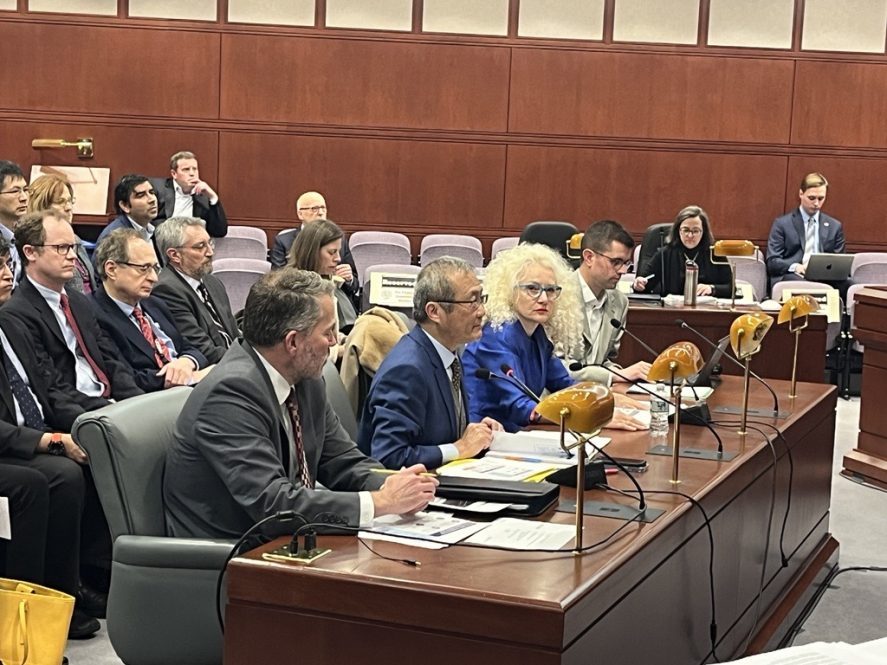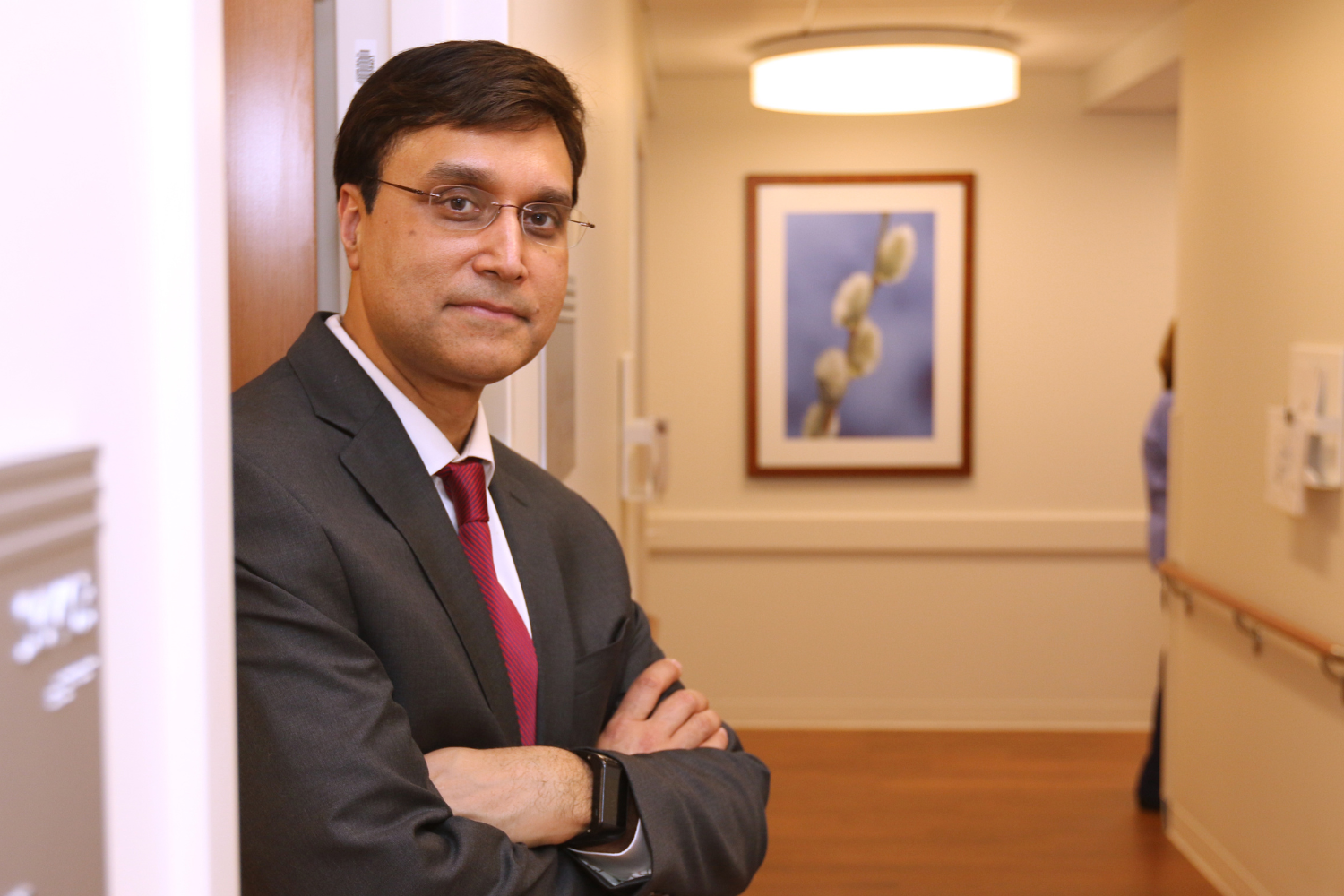For one afternoon, UConn researchers and clinicians found themselves educating a different audience than their usual grad students and residents: members of the Connecticut State Legislature.
On Monday, Feb. 26, more than a dozen faculty members of UConn and UConn Health joined with University leadership to present their research to the Finance, Revenue, and Bonding Committee. The speakers emphasized the need to connect their cutting-edge research directly into medical practice, something that would be much more difficult without a top health facility like UConn Health.
“Our students, faculty, and staff push the frontiers, and our research enterprise continues to compete at the highest level,” UConn President Radenka Maric said. “We are engaging in the necessary work to advance science and medicine that will positively impact the lives of people in this state and beyond. As an integrated health delivery system, that is what we must do – it is inherent in our responsibilities to teach, advance medical knowledge, and provide exemplary clinical care.”
The hearing was scheduled amid scrutiny of UConn Health as the legislature works with Governor Ned Lamont to establish the state’s budget. Committee Chairman Sen. John Fonfara, D-1st District (Hartford, Wethersfield), invited UConn to prove the importance and impact of UConn Health, which has benefited from $864 million from the Bioscience Connecticut investment.
Dr. Bruce Liang, the dean of the UConn School of Medicine and interim CEO of UConn Health, guided the committee through the breadth of the institute’s impact. Bioscience Connecticut has enabled the construction of several projects, lab and research space renovation, the establishing of the Technology Incubation Program’s Farmington startup incubator, and partnership with Jackson Laboratories.
“We have additional components for world-class infrastructure for research, education, and patient care,” Liang said.
The new and existing infrastructure serves as the backdrop for clinical care, the synergy of research and practice, and a clientele that has served residents from all 169 towns in the state. Financially, UConn Health has a $3.3 billion impact on the state, $2.5 billion on Connecticut’s GDP, and employs 5,800 people.
Moreover, the School of Medicine and School of Dental Medicine produce top doctors and dentists, the majority of whom stay in the state to practice. Researchers from those schools have earned hundreds of millions in research funding to support their work, in fields from prenatal care to geriatric medicine.
Excellent Care in Connecticut
Faculty members explained their research pursuits in detail, including Dr. Liisa Kuhn, a professor of biomedical engineering at the School of Dentistry. Applying 3-D printing techniques used to create dental implants, Kuhn has developed custom-printed breast prosthetics for women who have had mastectomies. For context, Connecticut has the second-highest percentage of residents who are diagnosed with breast cancer, as well as the lowest cancer death rate in the country.
“We have good early detection and good care, but there are a lot of cancer survivors, and some of them don’t necessarily want an implant of a foreign material in their body after just struggling with what’s just gone on with the surgically,” Kuhn said.
UConn specialists can provide services and perform surgeries that draw patients from all over the world. Dr. Ketan Bulsara and his research partner Dr. Daniel Roberts are brain surgeons in the Cranial Nerve and Brainstem Disorder Program. Bulsara explained that their technology has been able to save patients who were otherwise told their cases were hopeless, such as Rafael Azevedo, who traveled from Brazil for life-saving surgery following a decade of chronic pain.
“Senators and representatives, for patients like this and countless others who may have been denied care, they have access to world class care at UConn Health,” said Bulsara, the chief of Neurosurgery. “The treatment is complex, but our results have made us a destination center. Through a multidisciplinary team incorporating surgeons, researchers, and countless other collaborators immediately involved in patient care at UConn Health, we offer safe, effective, world-class surgery to areas of the brain once considered inaccessible.”
Other researchers found themselves drawn to UConn Health after beginning successful careers elsewhere. Dr. Margaret Callahan, an oncologist, spent 14 years at the renowned Memorial Sloan Kettering Cancer Center in New York. Her focus was developing cancer immunotherapies – teaching the body’s immune system to fight cancer – research she began while a UConn student.
“I really see that and deeply feel in an almost religious way that cancer patients benefit so much from the science that can be developed in an academic setting,” Callahan said. “Not every patient has the resources or the social support to travel for cancer care, and I think we have excellent opportunities here to develop and continue to develop cancer care that really gives similar if not the same opportunities right here at home for our patients in Connecticut. UConn really is the place to see that through.”
‘UConn is Our State University’
The presentations impressed the legislators, who later asked questions of the faculty members and UConn administration. Committee vice chair Rep. Kate Farrar, D-20th District (West Hartford, Newington), tied themes discussed to the recent change in the state’s marketing campaign, “Made in Connecticut.”
“If we want to make it here in Connecticut, if we want to make our economy innovative, we need to make sure that you are supported to produce the research that is essential for that innovation,” Farrar said.
Sen. Tony Hwang, R-28th District (Bethel, Easton, Fairfield, Newtown), said it was important to recognize that “UConn is our state university” and representative of how the rest of the country defines Connecticut. He complimented the innovations and solutions that build quality of life, especially in a competitive Northeast marketplace and against top minds from throughout the world. He asked about the fiscal challenges currently under debate and how perceptions impact ability to recruit research talent.
Maric responded that UConn is recruiting from the same talent pool as the rest of the best medical institutions in the country, many of whom make financial sacrifices to conduct research and practice in Connecticut.
“When you read about the top salaries and you see a doctor making $1 million, that same doctor at Emory University will be paid $1.5 million,” Maric said.
Concluding the hearing, Fonfara remarked that patients seeking care from top institutions for their families don’t care about dollars and cents, but rather cures and treatment.
“We want to be the best in basketball, if there was a game every night we’d be watching,” Fonfara said. “But when it comes to UConn Health, we want to look at it from a ledger, and that should not be who we are.”



